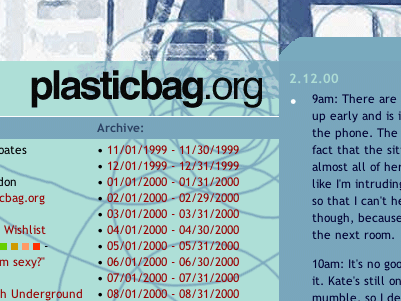Ladies and Gentlemen, it gives me great pleasure to direct your attention towards the new Radio 3 website, which I (along with a great number of other people from every discipline and from all across the BBC) have been working on for the last few months. The teams that created the site have been among the best I’ve ever worked with and if started naming names I’d be here all week.
But what’s so special about it, I hear you ask? Quite apart from the sterling design work from Paul Finn, we’ve been working with Radio 3’s team to make the site one of the most genuinely web-native sites I’ve ever seen – designed to effectively reflect the station’s programming online in a way that’ll be better for the site’s current users, for search engines and for anyone who would want to link to the site – including (but certainly not limited to) webloggers. Specifically the new site includes:
- A web page with a stable long-term URL for each and every episode of each and every programme that is broadcast on Radio 3 – a page that will always have basic information upon it, but can also be supplemented with more content by the production teams that actually make the programmes. (Lebrecht.live, World Routes’ “Cairo Nights” etc.)
- New schedule pages that are persistent and will remain on the site in perpetuity, each item upon which linking through to the specific episode page for that programme – allowing you to navigate to any episode of any show by the date and time it was broadcast upon (particularly useful for helping you to find out what was playing yesterday when you were listening to the radio in the car).
- Better navigational aids, including the ability to easily see when the next (and last) episodes of your favourite programmes are on, the ability to navigate between episodes of a programme by date, and a full daily schedule on the front page of the site, linking through to every episode.
- Improved URL structures, easily spiderable pages and nice content-related title tags that should make each page easier to bookmark and find through the BBC’s search engines and search engines across the web.
I could go on – I’m terribly proud of the work that everyone has done on the site and it’s only going to get better over the next few weeks. But good work be damned! The most important thing is that I think it’s going to serve the site’s users better – both existing, and (perhaps) people who’ve never listened to Radio 3 before and can now be exposed to its wealth of programming over the web more effectively than ever before.
PS. Hello to Leigh, Justin, Andrew, Gregory from Radio 3, Paul and Sarah from the Technology and Design team and everyone else who worked on the project: Zillah, Rija, Tim, Mike, Matt B, Paul C, Manjit, Ian, Jason, Tony, Clare, Dan, Webb, Chris K, Simon N and anyone else I might have forgotten about. And a special personal wave to Margaret Hanley and Gavin Bell for being the best creative partners and co-conspirators a boy could wish for. You all rock!







